16 books about Developing
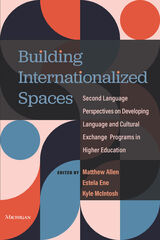
Building Internationalized Spaces
Second Language Perspectives on Developing Language and Cultural Exchange Programs in Higher Education
Edited by Matthew Allen, Estela Ene, and Kyle McIntosh
University of Michigan Press, 2022
This book provides case studies from several higher education contexts to represent the diverse ways that L2 specialists can build up programs and courses that contribute to their institutions' internationalization by promoting language and cultural exchange.
This volume contributes to emerging interdisciplinary conversations in higher education about how to refine internationalization in terms of praxis and how to coordinate curricular and pedagogical efforts to achieve meaningful learning outcomes for all students. The chapters provide suggestions for how L2 specialists can reframe their work in their individual programs to help internationalize the entire university in ways that lead to improved learning outcomes for students at different points in their degree programs, including:
This volume contributes to emerging interdisciplinary conversations in higher education about how to refine internationalization in terms of praxis and how to coordinate curricular and pedagogical efforts to achieve meaningful learning outcomes for all students. The chapters provide suggestions for how L2 specialists can reframe their work in their individual programs to help internationalize the entire university in ways that lead to improved learning outcomes for students at different points in their degree programs, including:
- Orientation programs (early arrival on campus, before classes start)
- Language Center contexts (support during studies)
- Volunteer programs for International Teaching Assistants (ITA) and undergraduate students
- Graduate-level writing support structures
- Instructional design (virtual learning spaces)
- Virtual Partner programs (co-curricular)
- Intercultural composition (placement, interdisciplinary collaborations)
[more]

Developing a Make or Buy Strategy for Manufacturing Business
David Probert
The Institution of Engineering and Technology, 1997
How can a company decide where to concentrate its expertise? Why are some companies better at exploiting their strengths than others? Is there a link between the range of a company's activities and its success and profitability?
[more]
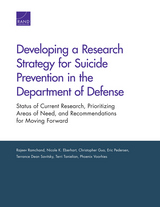
Developing a Research Strategy for Suicide Prevention in the Department of Defense
Status of Current Research, Prioritizing Areas of Need, and Recommendations for Moving Forward
Rajeev Ramchand
RAND Corporation, 2014
To support U.S. Department of Defense (DoD) efforts to create a unified, comprehensive strategic plan for suicide prevention research, a RAND study cataloged studies funded by DoD and other entities, examined whether current research maps to DoD’s strategic research needs, and provided recommendations to encourage better alignment and narrow the research-practice gap when it comes to disseminating findings to programs serving military personnel.
[more]
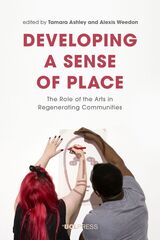
Developing a Sense of Place
The Role of the Arts in Regenerating Communities
Edited by Tamara Ashley and Alexis Weedon
University College London, 2020
Cultural planners, artists, and policy makers must work through the arts to create communities—and a place within them. Developing a Sense of Place brings together a series of case studies and success stories drawn from a different geographical or sociocultural contexts. Selected for their lasting effect in their local community, the case studies explore new models for opening up the relationship between universities and their surrounding regions, explicitly connecting creative, critical, and theoretical approaches to civic development. The studies cover various regions in the UK, and also areas in Brazil, Turkey, and Zimbabwe.
Developing a Sense of Place offers a range of viewpoints, including those of the arts strategist, the academic, the practice-researcher, and the artist. Through its innovative models, from performing arts to architectural design, the book serves diverse interests, such as the arts and cultural policy managers, master planners, and arts workers, as well as students of human geography, cultural planning, business and the creative industries, and arts administration, at the undergraduate and postgraduate levels.
Developing a Sense of Place offers a range of viewpoints, including those of the arts strategist, the academic, the practice-researcher, and the artist. Through its innovative models, from performing arts to architectural design, the book serves diverse interests, such as the arts and cultural policy managers, master planners, and arts workers, as well as students of human geography, cultural planning, business and the creative industries, and arts administration, at the undergraduate and postgraduate levels.
[more]

Developing an Outstanding Core Collection
A Guide for Libraries
Carol Alabaster
American Library Association, 2010

Developing and Maintaining Practical Archives
Gregory S. Hunter
American Library Association, 2003
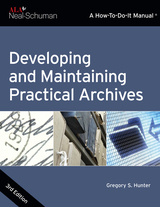
Developing and Maintaining Practical Archives
A How-To-Do-It Manual
Gregory S. Hunter
American Library Association, 2020
Since its original publication Hunter's manual has been "not only a rich and ready reference tool but also a practical resource for solving problems" (Catholic Library World), and no text has served as a better overview of the field of archives. Newly revised and updated to more thoroughly address our increasingly digital world, including integration of digital records and audiovisual records into each chapter, it remains the clearest and most comprehensive guide to the discipline. Former editor of American Archivist, the journal of the Society of American Archivists (SAA), Hunter covers such keystone topics as
- a history of archives, including the roles of historical societies and local history collections in libraries;
- new sections on community archives, diversity, and inclusion;
- conducting a survey and starting an archival program;
- selection, appraisal, acquisition, accessioning, and deaccessioning;
- important points of copyright, privacy, and ethics;
- arrangement of archival collections, with a discussion of new theories;
- description, including DACS, EAD, and tools such as ArchivesSpace;
- access, reference, and outreach, with a look at how recent innovations in finding aids can help researchers;
- preservation, including guidance on how to handle rare books, maps, architectural records, and artifacts;
- digital records, addressing new and popular methods of storage and preservation of email, social media, image files, webpages, Word documents, spreadsheets, databases, and media files;
- disaster planning, security, and theft prevention;
- metrics, assessment, establishing employee procedures and policies, working with interns and volunteers, and other managerial duties;
- public relations and marketing, from social media and the Web to advocacy; and
- professional guidelines and codes, such as the newly developed SAA Statement of Core Values of Archivists.
[more]

Developing and Managing Electronic Collections
The Essentials
Peggy Johnson
American Library Association, 2013
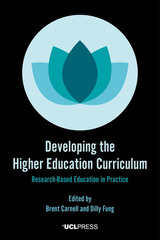
Developing the Higher Education Curriculum
Research-Based Education in Practice
Edited by Brent Carnell and Dilly Fung
University College London, 2017
Developing the Higher Education Curriculum showcases methods for engaging students with research across disciplines. It begins with UCL’s own approach to research-based education, then demonstrates how the framework can apply to various institutions. The fifteen chapters, by a diverse group of scholars, sometimes take a specific subject focus, while others examine tactics from international perspectives, but ultimately draw the conclusion that such curricula not only prepare students for advanced learning, but also for professional roles in complex environments.
[more]

Developing The Next Gen Library Leaders
ACRL Pub In Librarian
Lori Birrell
Assoc of College & Research Libraries, 2020

Developing the Teacher Workforce
Edited by Mark A. Smylie and Debra Miretzky
University of Chicago Press, 2004
This volume offers a systematic perspective on teacher workforce development, drawing on views that reflect local, direct, and national concerns about issues such as diversity in the workforce, recruitment and retention of teachers, effective professional development and compensation, and the effect of these workforce initiatives on teacher quality and student achievement.
The authors argue that current ways of thinking are inadequate for the nature of the work and future demands because of the neglect of the context, the lack of understanding of teacher career stages, and disregard of the "ripple effect" of educational policy. A coherent, cohesive approach must replace the fragmented and autonomous efforts that predominate today. The volume's authors demonstrate that until a more seamless and comprehensive human resource system is employed, widespread improvements in teacher quality are unlikely and the quality of learning will itself remain compromised.
The authors argue that current ways of thinking are inadequate for the nature of the work and future demands because of the neglect of the context, the lack of understanding of teacher career stages, and disregard of the "ripple effect" of educational policy. A coherent, cohesive approach must replace the fragmented and autonomous efforts that predominate today. The volume's authors demonstrate that until a more seamless and comprehensive human resource system is employed, widespread improvements in teacher quality are unlikely and the quality of learning will itself remain compromised.
[more]
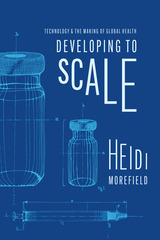
Developing to Scale
Technology and the Making of Global Health
Heidi Morefield
University of Chicago Press, 2023
The first critical book on “appropriate technology,” Developing to Scale shows how global health came to be understood as a problem to be solved with the right technical interventions.
In 1973, economist E. F. Schumacher published Small Is Beautiful, which introduced a mainstream audience to his theory of “appropriate technology”: the belief that international development projects in the Global South were most sustainable when they were small-scale, decentralized, and balanced between the traditional and the modern. His theory gained widespread appeal, as cuts to the foreign aid budget, the national interests of nations seeking greater independence, postcolonial activism, and the rise of the United States’ tech sector drove stakeholders across public and private institutions toward cheaper tools. In the ensuing decades, US foreign assistance shifted away from massive modernization projects, such as water treatment facilities, toward point-of-use technologies like village water pumps and oral rehydration salts. This transition toward the small scale had massive implications for the practice of global health.
Developing to Scale tells the history of appropriate technology in international health and development, relating the people, organizations, and events that shaped this consequential idea. Heidi Morefield examines how certain technologies have been defined as more or less “appropriate” for the Global South based on assumptions about gender, race, culture, and environment. Her study shows appropriate technology to be malleable, as different constituencies interpreted its ideas according to their own needs. She reveals how policymakers wielded this tool to both constrain aid to a scale that did not threaten Western interests and to scale the practice of global health through the development and distribution of technical interventions.
In 1973, economist E. F. Schumacher published Small Is Beautiful, which introduced a mainstream audience to his theory of “appropriate technology”: the belief that international development projects in the Global South were most sustainable when they were small-scale, decentralized, and balanced between the traditional and the modern. His theory gained widespread appeal, as cuts to the foreign aid budget, the national interests of nations seeking greater independence, postcolonial activism, and the rise of the United States’ tech sector drove stakeholders across public and private institutions toward cheaper tools. In the ensuing decades, US foreign assistance shifted away from massive modernization projects, such as water treatment facilities, toward point-of-use technologies like village water pumps and oral rehydration salts. This transition toward the small scale had massive implications for the practice of global health.
Developing to Scale tells the history of appropriate technology in international health and development, relating the people, organizations, and events that shaped this consequential idea. Heidi Morefield examines how certain technologies have been defined as more or less “appropriate” for the Global South based on assumptions about gender, race, culture, and environment. Her study shows appropriate technology to be malleable, as different constituencies interpreted its ideas according to their own needs. She reveals how policymakers wielded this tool to both constrain aid to a scale that did not threaten Western interests and to scale the practice of global health through the development and distribution of technical interventions.
[more]

Digital Library Programs for Libraries and Archives
Developing, Managing, and Sustaining Unique Digital Collections
Aaron D. Purcell
American Library Association, 2016
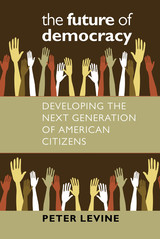
The Future of Democracy
Developing the Next Generation of American Citizens
Peter Levine
University Press of New England, 2015
We need young people to be civically engaged in order to define and address public problems. Their participation is important for democracy, for institutions such as schools, and for young people themselves, who are more likely to succeed in life if they are engaged in their communities. In The Future of Democracy, Peter Levine, scholar and practitioner, sounds the alarm: in recent years, young Americans have become dangerously less engaged. They are tolerant, patriotic, and idealistic, and some have invented such novel and impressive forms of civic engagement, as blogs, “buycott” movements, and transnational youth networks. But most lack the skills and opportunities they need to participate in politics or address public problems. Levine’s timely manifesto clearly explains the causes, symptoms, and repercussions of this damaging trend, and, most importantly, the means whereby America can confront and reverse it. Levine demonstrates how to change young people’s civic attitudes, skills, and knowledge and, equally importantly, to reform our institutions so that civic engagement is rewarding and effective. We must both prepare citizens for politics and improve politics for citizens.
[more]
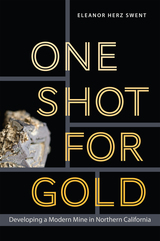
One Shot for Gold
Developing a Modern Mine in Northern California
Eleanor Herz Swent
University of Nevada Press, 2021
Winner of the 2023 Clark Spence Award from the Mining History Association!
An account of the creation of a modern, environmentally sensitive mine as told by the people who developed and worked it.
In 1978, a geologist working for the Homestake Mining Company discovered gold in a remote corner of California’s Napa County. This discovery led to the establishment of California’s most productive gold mine in the twentieth century. Named the McLaughlin Mine, it produced about 3.4 million ounces of gold between 1985 and 2002. The mine was also one of the first attempts at creating a new full-scale mine in California after the advent of environmental regulations and the first to use autoclaves to extract gold from ore.
One Shot for Gold traces the history of the McLaughlin Mine and how it transformed a community and an industry. This lively and detailed account is based largely on oral history interviews with a wide range of people associated with the mine, including Homestake executives, geologists, and engineers as well as local neighbors of the mine, officials from county governments, townspeople, and environmental activists. Their narratives— supported by thorough research into mining company documents, public records, newspaper accounts, and other materials—chronicle the mine from its very beginning to its eventual end and transformation into a designated nature reserve as part of the University of California Natural Reserve System.
A mine created at the end of the twentieth century was vastly different from the mines of the Gold Rush. New regulations and concerns about the environmental, economic, and social impacts of a large mine in this remote and largely rural region of the state-required decisions at many levels. One Shot for Gold offers an engaging and accessible account of a modern gold mine and how it managed to exist in balance with the environment and the human community around it.
An account of the creation of a modern, environmentally sensitive mine as told by the people who developed and worked it.
In 1978, a geologist working for the Homestake Mining Company discovered gold in a remote corner of California’s Napa County. This discovery led to the establishment of California’s most productive gold mine in the twentieth century. Named the McLaughlin Mine, it produced about 3.4 million ounces of gold between 1985 and 2002. The mine was also one of the first attempts at creating a new full-scale mine in California after the advent of environmental regulations and the first to use autoclaves to extract gold from ore.
One Shot for Gold traces the history of the McLaughlin Mine and how it transformed a community and an industry. This lively and detailed account is based largely on oral history interviews with a wide range of people associated with the mine, including Homestake executives, geologists, and engineers as well as local neighbors of the mine, officials from county governments, townspeople, and environmental activists. Their narratives— supported by thorough research into mining company documents, public records, newspaper accounts, and other materials—chronicle the mine from its very beginning to its eventual end and transformation into a designated nature reserve as part of the University of California Natural Reserve System.
A mine created at the end of the twentieth century was vastly different from the mines of the Gold Rush. New regulations and concerns about the environmental, economic, and social impacts of a large mine in this remote and largely rural region of the state-required decisions at many levels. One Shot for Gold offers an engaging and accessible account of a modern gold mine and how it managed to exist in balance with the environment and the human community around it.
[more]
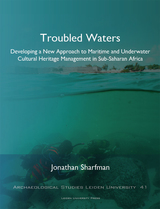
Troubled Waters
Developing a New Approach to Maritime and Underwater Cultural Heritage Management in Sub-Saharan Africa
Jonathan Sharfman
Leiden University Press, 2018
This 41th volume of the ASLU series examines perspectives on maritime and underwater cultural heritage (MUCH) in southern Africa and proposes new management approaches to advance protection and public engagement. By redefining the maritime historical narratives in countries that have predominantly interpreted their maritime past through colonial shipwrecks, it is possible to create an environment in which stakeholders become active participants in heritage management. The application of a broad maritime cultural landscape perspective that blurs the lines between the natural and cultural, tangible and intangible, and local and global binaries that are often applied to MUCH, results in a community-driven, relevant approach to heritage management. Appropriate management strategies are supported by balancing western based heritage values with alternative approaches to heritage conservation. Case studies illustrate the evolution and efficacy of this approach
[more]
READERS
Browse our collection.
PUBLISHERS
See BiblioVault's publisher services.
STUDENT SERVICES
Files for college accessibility offices.
UChicago Accessibility Resources
home | accessibility | search | about | contact us
BiblioVault ® 2001 - 2024
The University of Chicago Press









